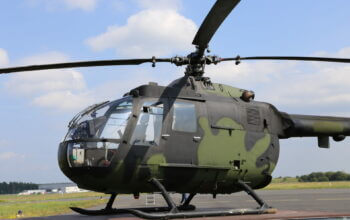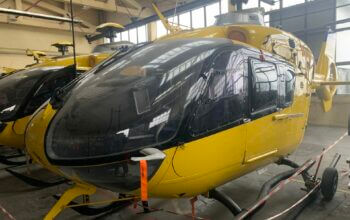Estimated reading time 9 minutes, 58 seconds.
The Canadian government has submitted a letter of request (LOR) to the U.S. government for the acquisition price of 16 Boeing built P-8A Poseidon aircraft to replace the Royal Canadian Air Force (RCAF) fleet of 14 CP-140 Aurora maritime patrol aircraft.
In a statement, the government said it had submitted the LOR after gathering feedback from a request for information (RFI) issued to the defense and aerospace industry in February 2022. Based on the RFI, the government contends the P-8A is “the only currently available aircraft that meets all of the operational requirements” for what it is calling the Canadian Multi-Mission Aircraft (CMMA) project to provide the RCAF with a next-generation anti-submarine warfare and intelligence, surveillance, and reconnaissance (ISR) platform.
The Poseidon “is a proven capability that is operated by several of Canada’s defense partners,” the government noted, including all of the Five Eyes allies — the United States, United Kingdom, Australia, New Zealand — as well as Norway, and South Korea. The aircraft has also recently been acquired by Germany.

The 16 aircraft would be procured through the Foreign Military Sales (FMS) program and would include associated equipment and initial servicing, as well as access to intellectual property and technical data.
“The issuance of a LOR does not commit Canada to purchasing the P-8A Poseidon and the project remains in options analysis,” the government emphasized in its statement. “The final decision will be based on the capability offered, availability, pricing, and benefits to Canadian industry.”
The Auroras were originally acquired in 1980 and are scheduled to retire in 2030. The entire fleet recently completed the fourth and final phase of a complex modernization project that began in the early 2000s and has included new avionics, communications, mission management and radar and other sensors, as well as beyond line-of-sight (BLOS) wideband satellite communications, Link 16 tactical data exchange network access, and infrared counter measures for self defense. The airframes have also undergone a structural life extension that replaced the outer wings, the lower section of the center wing, the horizontal stabilizers, and other components subject to fatigue.
The RCAF has been discussing an eventual CP-140 replacement project more frequently since the government made the CMMA project one of 13 Air Force investments in the 2017 defense policy.
In presentations to industry, the RCAF has described the eventual CMMA solution as a system of systems that could involve multiple aircraft — including remotely piloted platforms — rather than simply a one-for-one replacement.
“We are looking to take advantage of technology,” Col Dave Pletz, director of air requirements, told Skies in 2021. The baseline for a new platform is the current CP-140, he said, but “we see this project having outstanding potential to bring much more than what the CP-140 is able to do now.”
In the RFI to industry last February, the government laid out 13 high-level mandatory requirements for the project, but also invited feedback on acquiring one or more manned military off-the shelf (MOTS) fleets with few or no modifications; a modified MOTS platform; a militarized civilian off-the-shelf (COTS) airframe; or a mix of piloted and remotely piloted MOTS fleets.
When media reported in late 2022 that Defence Minister Anita Anand was considering the sole-source acquisition of around a dozen P-8As — after Boeing warned potential customers that the P-8 production line could close by 2025 if it does not receive additional orders — Montreal-based Bombardier responded with a release urging the government to keep the bidding process open to other options.
In a recent interview with Skies, Éric Martel, president and CEO of Bombardier, argued that the Canadian-built Global 6500 aircraft would be “an excellent option” for the CMMA project, noting that the state-of-the-art platform has the proven endurance and reliability for anti-submarine and ISR missions.
Moreover, Global jets “have been evaluated and chosen for special missions by the U.S. Air Force, as well as by the U.K., Germany, and Sweden, among others,” he said.
“The Global 6500 aircraft’s next-generation engines and leading aerodynamic profile contribute to excellent operating costs and, more importantly, leave a lower carbon footprint. We hope that the CMMA will be open to diverse proposals, because we would be honored to present our made-in-Canada solution.”
While the Global 6500 may be a “made-in-Canada” option, Team Poseidon has partnered with several Canadian aerospace companies, including CAE, GE Aviation Canada, IMP Aerospace & Defence, KF Aerospace, Honeywell Aerospace Canada, and Raytheon Canada.
“The team builds on 81 Canadian suppliers to the platform and to more than 550 Canadian suppliers across all provinces contributing to Boeing’s annual C$5.3 billion in economic benefit to Canada, supporting more than 20,000 Canadian jobs,” Boeing said in a statement.
While the P-8 is built on Boeing’s 737NG platform, the OEM has publicly stated that the developmental costs to convert the commercial 737NG into the P-8 are $7 billion. A Global 6500 option, however, would mean that Canada would bear the developmental costs, plus the many years of development required to field the type.
Bombardier’s Martel dismissed the suggestion that a Canadian custom-built option would be more expensive.
“We should keep in mind that business jets are less expensive to operate than commercial airliners, not to mention the reduced environmental footprint of a smaller aircraft,” he said. “Moreover, a Canadian-built option for CMMA would be an investment in our Canadian workforce and would drive innovation within our borders.”

Currently, four of the Five Eyes nations are operating the P-8. A 6500 option would mean that Canada would once again be the only one among its allies operating an orphan aircraft. With the introduction of the CH-148 Cyclone, Canada — which is the only country to operate the Cyclone — learned many lessons when it comes to operating an orphan aircraft within NATO, especially when it comes to supportability when deployed abroad.
Boeing’s P-8, which shares 86 percent commonality with the commercial 737NG aircraft, already has a well-established global supply chain to provide logistical support.
Over 150 of the multi-mission aircraft are now in service and have accumulated more than 500,000 flight hours on operations with profiles similar to those described by the Air Force in its 13 mandatory requirements, noted Sean Liedman, Boeing’s director of mobility and surveillance business development, in an interview last year.
“[Those] are the same mission sets that are listed in the RFI – anti-submarine warfare, anti-surface warfare, ISR, search-and-rescue, humanitarian assistance, and disaster relief,” he said. “The P-8 truly has off-the-shelf, out-of-the-box capability across all 13 high-level requirements.”
In a statement released late on March 27, Boeing said that “we look forward to working with the U.S. and Canadian governments to finalize this sale under the Foreign Military Sales process. Together with our Canadian industry partners, we are committed to delivering 100 percent Industrial and Technical Benefits that will significantly grow Canada’s aerospace and defense industry.”









Bombardier fails to comprehend that a business jet cannot launch torpedoes and Canada never seems to learn that every time Ontario and Quebec are allowed to wade into these procurements going back to the 1950s Canadian taxpayers start hemorrhaging cash ,had we opted for the iver hutfeldt frigates we would already be operating them
Brad couldn’t have said it better. There might be a place for 2-4 specialized planes for Bombardier but not for CMMA. Bombardier continues to stand there with their hands out looking for charity.
You cannot complete an ASW mission without the capability to launch Torpedo’s or anti-surface rockets. Case closed for the Bombardier 6500 option.
There have been two MPA versions of the Global. Saab’s Swordfish and PAL Aerospace’s P-6.
Both had underwing hardpoints allowing the carriage of ASMs, SAR Kits, and yes, torpedoes. The P-6 even has an internal ‘flex bay’.
Compared to the US-standard P-8A, both the Swordfish and the P-6 had MAD booms, 360° radar, and an ability to carry more buoys, while operating for longer further from base.
Brad, Ron and John are wrong.
The P-8I version has rear radar and MAD as well. MAD requires to fly very low (ideally around 200-300ft) which is something a turbofan-equipped aircraft like the 737 or Global are not particularly well suited for so it was deemed unnecessary by Boeing. The range of the Global might look good on paper but that’s for an empty passenger plane. Add ordnance and additional drag of pylons and antennas and what not and the range and endurance figures drop dramatically. It could be a good surveillance or ISR platform but there is absolutely no way a Global could be superior to the P-8 as a truly multimission warplane. The interoperability factor is also way more important than what people think. You get stuck somewhere in the world and you just ask your allies for a part instead of waiting a week, wasting ressources to deliver it and cancelling missions due to being grounded.